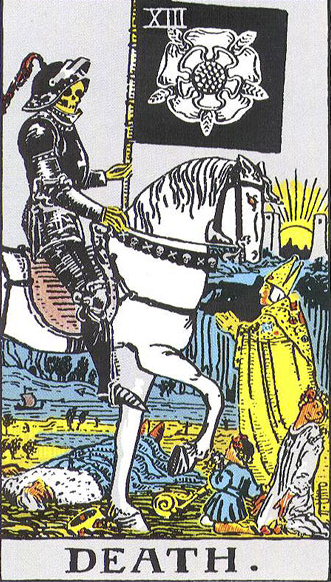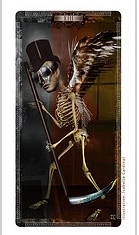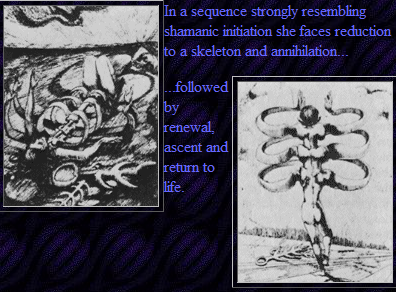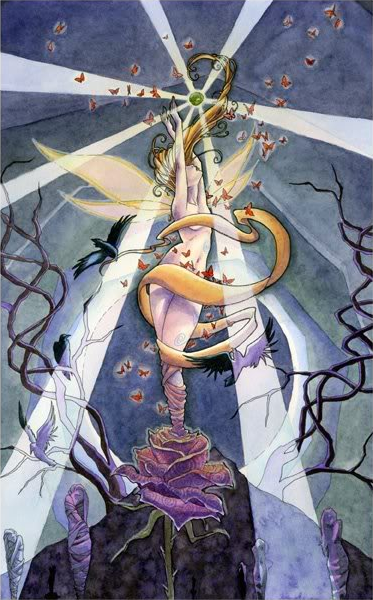
JAMES BOND: What do you expect me to do, Goldfinger?
GOLDFINGER: Why, Mr. Bond, I expect you to die.
From Goldfinger screenplay by
Richard Maibaum and Paul Dehn
We are all expected to die. We don’t know when. We don’t know where. We don’t know how. And we don’t know what, if anything, will happen afterward. The only thing we know for certain is that it is the end of life on earth as we know it.
 So if it’s the end, why isn’t Death the last of the major arcana cards? If the card has a number, it is always 13, that most infamous of integers. Even today many buildings do not possess a thirteenth floor, and otherwise sane citizens look over their shoulders a bit more often whenever Friday the 13th rolls around. It’s not an auspicious number, but it’s not the last number, which is 21, The World, completion. According to the tarot, Death is not the end.
So if it’s the end, why isn’t Death the last of the major arcana cards? If the card has a number, it is always 13, that most infamous of integers. Even today many buildings do not possess a thirteenth floor, and otherwise sane citizens look over their shoulders a bit more often whenever Friday the 13th rolls around. It’s not an auspicious number, but it’s not the last number, which is 21, The World, completion. According to the tarot, Death is not the end.
Since the major arcana cards outline the story of the hero’s journey, this means that Death falls in the center of the story, not the end. The hero must die so he can be reborn as a new and improved person capable of overcoming the forces arrayed against him. This ordeal usually takes the form of a near death or a crisis that he fears as much if not more than death. It shatters him completely. But during this dark night of the soul a magical transformation happens, leaving the hero with new abilities or a different point of view. But this usually isn’t the final climax of the story. The transformed hero must still complete his mission.
This spiritual death and rebirth theme is, of course, central to many spiritual practices. Christianity is the example that comes most quickly to the western mind, but it is also the purpose of a shamanic initiation.

In his book, Serpent in the Sky, John Anthony West describes the initiation of a shaman of the eastern Siberian Yakout tribe: “A Yakout shaman, Sofron Zatayev, affirms that customarily the future shaman dies and spends three days without food and drink. Formerly one was subjected to a thrice-performed ceremony during which he was cut in pieces. Another shaman, Pyorty Ivanov, told us about this ceremony in detail: the members of the candidate were detached and spearated with an iron hook, the bones were cleaned, the flesh scraped, the body liquids thrown away and the eyes torn out of their sockets. After this operation the bones were reassembled and joined with iron. According to another shaman, the dismembering ceremony lasted three to seven days: during this time the candidate remained in suspended animation, like a corpse, in a solitary place.” West, 146, from Robert Lafont in Encyclopedies des Mystiques.
The initiate is literally stripped to the bone, dismembered, and put back together. He must die to his old life so that he can become fit to be reborn into a new and better one. Death, transformation, and rebirth can happen once or many times, and not just at the end of this life. It is the way the soul grows and becomes stronger; it is the way a hero overcomes seemingly insurmountable obstacles.
According to the tarot, Death teaches us how to live heroic, inspired lives that bring joy and justice to a struggling world.



2 thoughts on “The Major Arcana and the Hero’s Journey: Death, Part I”
Dear Madame, I’m seeking the real botanical identity of the Assyrian Sacred Tree. Do you know it? please answer edzard.klapp@gmx.de
I put your query out to my community and someone wrote back that it was Acacia tortilis. Held sacred by many in North Africa, the Middle East. The resin combined with Syrian Rue, earns it sacred status.
However, a quick perusal of the internet indicates that there is much debate, with most sources going with a stylized version of a date palm.
You might check out these two sites.
http://www.gatewaystobabylon.com/introduction/sonsofgod.htm
http://uk.answers.yahoo.com/question/index?qid=20070121033813AA9EIPT
There’s also a whole book about it.
Mariana Giovino: The Assyrian Sacred Tree. A History of Interpretations. Orbis Biblicus et Orientalis 230. Fribourg: Academic Press; Gottingen: Vandenhoek & Ruprecht, 2007. 242 pp. ISBN 978-3-7278-1602-4, 978-3-525-53028-3.